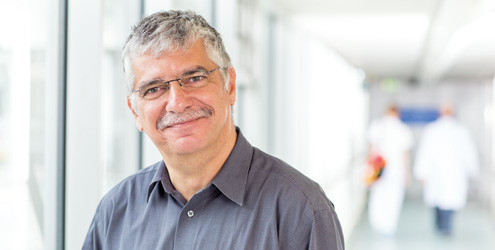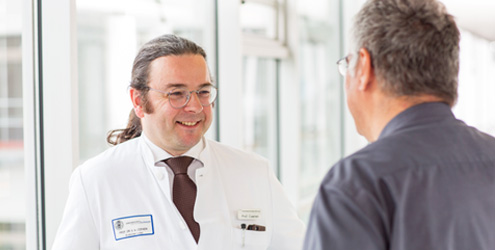Parkinson's disease - almost symptom-free after deep brain stimulation
Dr. Deniz Özbilen suffers from Parkinson's disease. After undergoing deep brain stimulation at the University Medical Center Freiburg, he is virtually symptom-free.

"The first time I realized that something was wrong was when I tried to do banking transactions and my signature was no longer accepted," recalls Deniz Özbilen. That was eight years ago. The now 54-year-old had often had muscle tension and back pain before, but he was unable to classify these symptoms. The diagnosis was correspondingly shocking: Deniz Özbilen had Parkinson's disease - of the akinetic-rigid type, as the experts say. This means that instead of trembling, his muscles became increasingly stiff and his movements more jerky, as if gears were meshing. A world collapsed for the SAP software architect with a doctorate. He was only 46 years old and wanted to settle down with his family and build a house. He also had big plans for his career.
"I saw Prof. Coenen in a television report. He used deep brain stimulation on Parkinson's patients who no longer showed any symptoms afterwards," says Özbilen. "I couldn't imagine having 'antennas' implanted in my head, but the procedure impressed me and that's why I went to see him." In deep brain stimulation, electrodes are attached to a previously localized area via a small hole in the skull. These send electrical impulses to the nerve structures to be activated, whereupon the symptoms - such as tremors in Parkinson's tremor - disappear immediately.
"I can still remember exactly how Mr. Özbilen first came to see me," says Prof. Dr. med. Volker A. Coenen, who heads the Department of Stereotactic and Functional Neurosurgery at the Freiburg University Medical Center. "At that time, however, it was still too early for an operation. All other treatment options had to be exhausted first. At that time, it was also not clear whether Mr. Özbilen would ever need deep brain stimulation." After a sophisticated drug therapy by the treating neurologists, which worked very well but unfortunately only lasted for two years, the father of the family finally came back to Prof. Coenen. The neurologists treating him had advised him to undergo deep brain stimulation therapy.

"I went to see him in Freiburg on September 9, 2014. He said that I had now actually become a candidate for deep brain stimulation and he took a lot of time to talk to me." At the end of October, the time had come for the operation to take place. "It was a very intense experience for me; I'm still in tears today." The operation began at 7.30 in the morning. Deniz Özbilen's head was fixed in a so-called stereotactic frame with a targeting device attached to it. He was conscious at times during the operation so that the success of the procedure could be tested directly. First, the test electrode was inserted through a hole in the skull.
While the electrodes were lowered, the doctors tested the patient's motor skills. "Prof. Coenen kept holding my hand while a colleague operated and said that everything was going well." The pacemaker was then implanted in the collarbone under general anesthesia.
Prof. Coenen and his team perform a total of around 350 surgical procedures on the brain each year - 40-50 of which are deep brain stimulations. With an appropriately high number of operations, routine treatment of patients is ensured at the University Hospital. "The quality of an operation always depends on the number of cases and therefore on the experience of a team. If a hospital performs a difficult operation such as deep brain stimulation frequently, this increases the experience and also the safety for the patient. In addition, a university hospital can offer its patients the opportunity to take part in studies and thus benefit from the latest treatment methods," emphasizes Prof. Coenen.
Dr. Deniz Özbilen was discharged after a successful operation on November 11, 2014, and stimulation was switched on just under a month later. "It was as predicted. My symptoms have completely disappeared. I can move normally again. I can walk again, ride my bike again and go skiing again. And I can play soccer with my son again." He visits Prof. Coenen every three months to ensure that the stimulation is working properly.
After his operation, the software architect continued to climb the career ladder. He then decided to take early retirement, not least because Prof. Coenen recommended that he take a step back. But Deniz Özbilen can't do nothing. He repairs vintage car engines, assembles computers and sets up PC networks. He also wants to teach his software skills to students and is already planning a big trip to the USA with his family.
Corporate Communications
Breisacher Straße 153
79110 Freiburg
Phone: 0761 270-84830
Fax: 0761 270-9619030
kommunikation@uniklinik-freiburg.de

